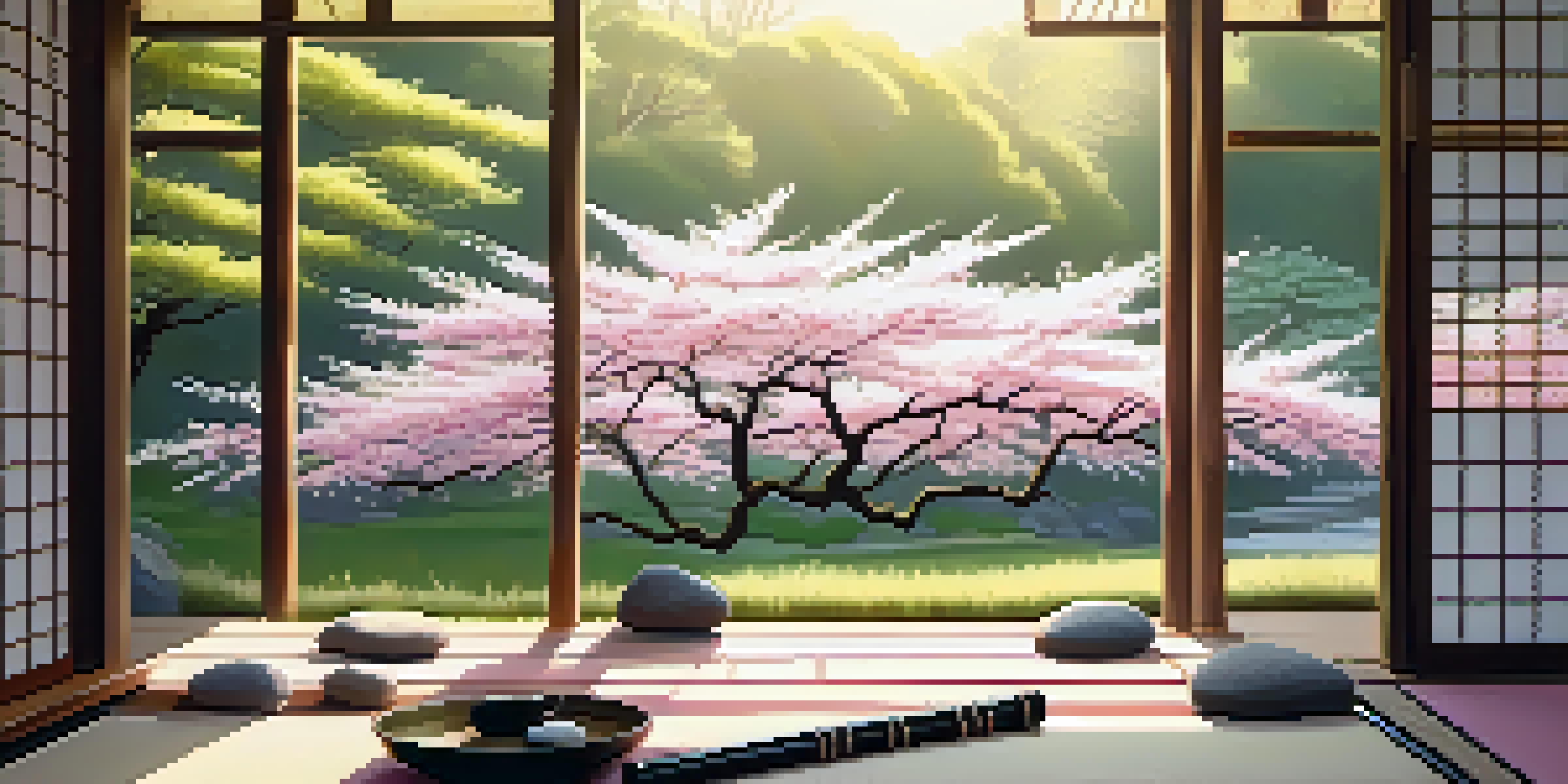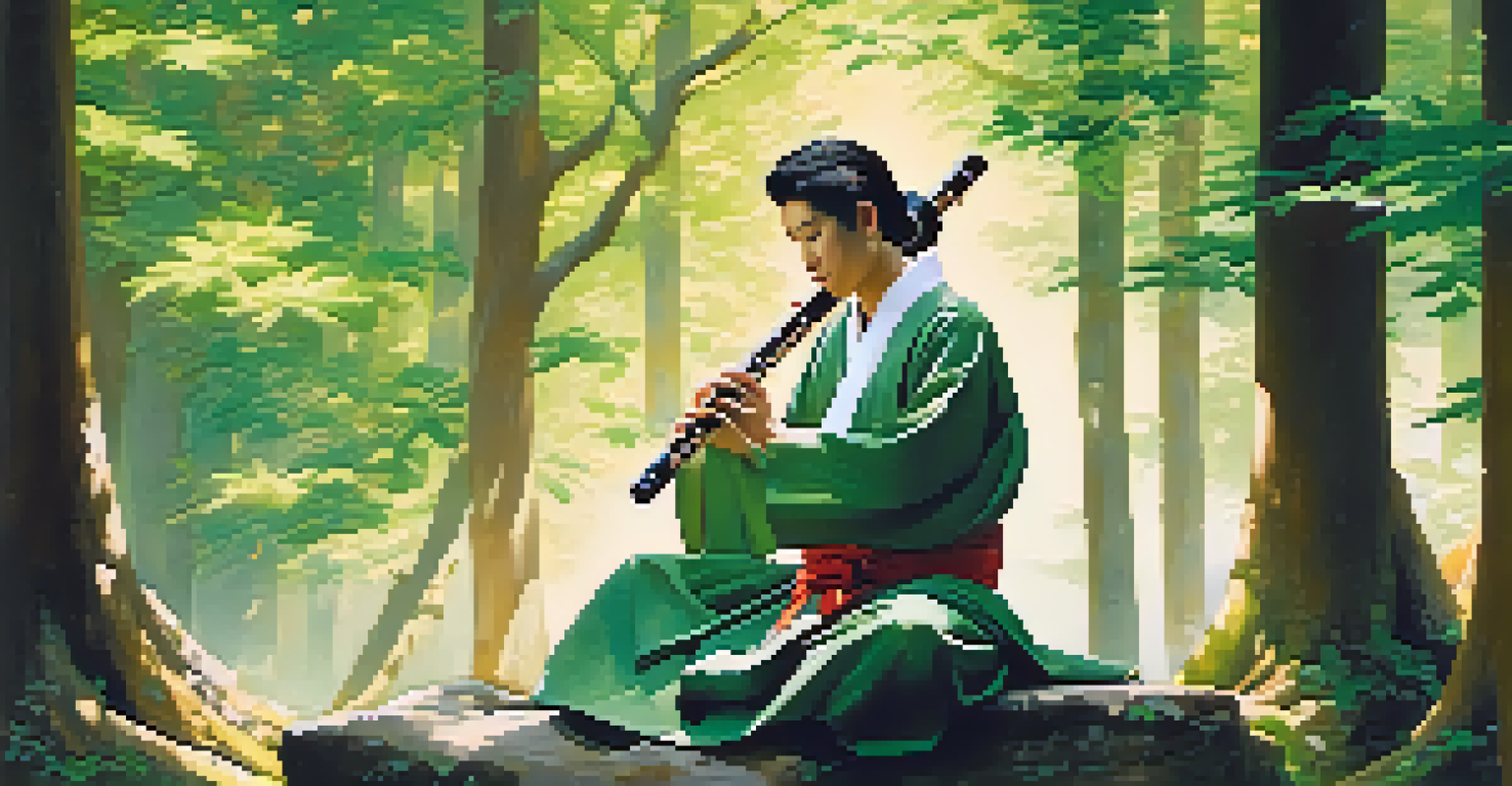The Shakuhachi: A Japanese Bamboo Flute with Spiritual Ties

Introduction to the Shakuhachi and Its Origins
The Shakuhachi is a traditional Japanese bamboo flute that has captivated musicians and audiences alike for centuries. Originating in the 8th century, its unique sound and cultural significance have made it a symbol of Japanese music. Historically, it was used by Zen Buddhist monks as a tool for meditation, bridging the gap between music and spirituality.
Music is the shorthand of emotion.
Crafted from a single piece of bamboo, the Shakuhachi is known for its distinct five holes, which allow for a wide range of expressive tones. This simple yet elegant design reflects the philosophy of minimalism that is prevalent in Japanese culture. The flute’s name itself translates to 'one foot, eight inches,' referring to its length, which is approximately 54 cm.
As we delve deeper into its history, we'll discover how the Shakuhachi evolved from a mere musical instrument into a spiritual companion for practitioners seeking enlightenment. Its rich sound is often likened to the voice of nature, creating a serene atmosphere that resonates with the soul.
The Spiritual Connection of the Shakuhachi
The Shakuhachi holds a profound spiritual significance, especially within the Zen Buddhist tradition. Monks would use the flute during meditation to help them attain a state of mindfulness and tranquility. This practice, known as 'suizen,' or 'blowing meditation,' emphasizes the importance of breath and sound in achieving spiritual clarity.

Through the act of playing the Shakuhachi, practitioners believe they can connect with their inner selves and the universe. The flute's haunting melodies echo the natural world, creating a bridge between the material and spiritual realms. Each note encourages listeners to pause, reflect, and immerse themselves in the present moment.
Shakuhachi's Spiritual Significance
The Shakuhachi is deeply intertwined with Zen Buddhism, serving as a tool for meditation and mindfulness.
Moreover, the Shakuhachi is often associated with the concept of impermanence, a core tenet of Buddhism. Just as the sound fades away, so do our worries and distractions, reminding us to embrace the transient nature of life. This deep connection to spirituality makes the Shakuhachi much more than just a musical instrument.
The Craftsmanship Behind the Shakuhachi
Crafting a Shakuhachi is an art form in itself, requiring immense skill and dedication. Traditionally made from the bamboo species known as 'madake,' the flute is meticulously shaped and tuned to produce its signature sound. The process involves selecting the right piece of bamboo, harvesting it at the correct time, and then carefully hollowing it out to create the desired pitch.
The flute is a remarkable instrument, and it has the power to create a deep sense of connection between the player, the audience, and the universe.
Each Shakuhachi is unique, with its own character and timbre influenced by the specific bamboo used and the craftsman's techniques. This individuality adds to the allure of the instrument, as players often form a personal connection with their flute. The craftsmanship speaks to the Japanese cultural value of 'wabi-sabi,' which celebrates imperfection and the beauty of natural materials.
Moreover, contemporary artisans have begun to experiment with different types of bamboo and innovative designs, blending tradition with modern aesthetics. This evolution keeps the Shakuhachi relevant in today's music scene while honoring its rich heritage.
Learning to Play the Shakuhachi
Learning to play the Shakuhachi can be both a rewarding and challenging journey. Unlike many Western instruments, the Shakuhachi requires a unique embouchure, or way of shaping the mouth, to produce sound. This distinctive technique can take time to master, but the effort is well worth it for the soulful melodies that emerge.
Many beginners start by taking lessons from experienced players or enrolling in workshops focused on traditional techniques. These learning environments emphasize not just the mechanical aspects of playing but also the spiritual and meditative qualities of the instrument. This holistic approach nurtures a deeper understanding of the Shakuhachi as a tool for personal expression and mindfulness.
Craftsmanship and Individuality
Each Shakuhachi is uniquely crafted from bamboo, reflecting the artisan's skill and the beauty of natural materials.
As players progress, they often find that the Shakuhachi becomes a means of self-discovery, allowing them to express emotions and stories through music. With patience and practice, the enchanting sounds of the Shakuhachi can become a part of one's life, creating a cherished connection to Japanese culture.
The Role of the Shakuhachi in Modern Music
In recent years, the Shakuhachi has found a place in various musical genres, blending traditional Japanese sounds with contemporary styles. Musicians around the world are integrating the flute into jazz, world music, and even electronic compositions, showcasing its versatility and universal appeal. This fusion not only brings new life to the instrument but also introduces its beauty to wider audiences.
Collaborations between Shakuhachi players and artists from different backgrounds have created innovative sounds that resonate across cultures. For example, the blending of Shakuhachi with ambient music creates a meditative soundscape that can transport listeners to serene landscapes. Such musical experimentation highlights the flute's adaptability while respecting its roots.
Moreover, the growing interest in mindfulness and wellness has led to a resurgence in the popularity of the Shakuhachi. Many wellness practitioners incorporate its soothing sounds into yoga and meditation sessions, enhancing the overall experience and promoting relaxation. This renewed appreciation reflects the timeless connection between music and spirituality.
The Shakuhachi in Popular Culture
The Shakuhachi has also made its mark in popular culture, appearing in films, television shows, and art. Its ethereal sound has been used in various soundtracks, enhancing emotional moments and transporting viewers to different settings. This exposure has introduced the instrument to a broader audience, sparking interest in its history and significance.
Artists and filmmakers often use the Shakuhachi to evoke feelings of nostalgia, tranquility, or introspection. For instance, you might hear it in scenes set in beautiful natural landscapes, as the flute's sound mirrors the beauty of the environment. This connection reinforces the idea that music can evoke powerful emotions and memories.
Modern Fusion in Music
The Shakuhachi is being integrated into contemporary music genres, showcasing its versatility and broadening its appeal.
Additionally, social media has played a crucial role in popularizing the Shakuhachi among younger generations. Many aspiring musicians share their interpretations and original compositions online, creating a vibrant community that celebrates this ancient instrument. This digital renaissance emphasizes that the Shakuhachi is not just a relic of the past but a living, evolving form of art.
Preserving the Legacy of the Shakuhachi
As the Shakuhachi continues to evolve, efforts are underway to preserve its rich heritage and promote traditional techniques. Various organizations and cultural institutions are dedicated to ensuring that the knowledge of crafting and playing the Shakuhachi is passed down to future generations. This commitment to preservation is essential for maintaining the instrument's cultural significance.
Workshops, festivals, and performances celebrate the Shakuhachi's history while encouraging new players to engage with its timeless beauty. These events foster a sense of community among musicians and enthusiasts, creating opportunities for collaboration and learning. By bringing people together, the Shakuhachi's legacy is not only preserved but also enriched.

Ultimately, the Shakuhachi serves as a reminder of the power of music to transcend time and culture. Its ability to connect people on a spiritual level reinforces the importance of preserving this unique tradition in an ever-changing world.